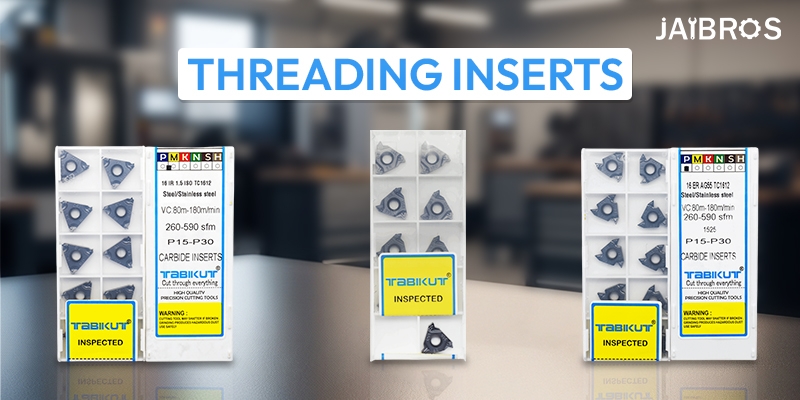Why Quality Threading Inserts Improve Surface Finish
Producing accurate, high-quality threads is important for all types of machining, from small components to large production parts. One of the greatest contributors to thread performance is the insert you are using. A well-developed threading insert will form thread geometry while enhancing surface finish, tool life and repeatability. In this blog we will cover why quality is important, how different materials respond, and what machinists should consider to see the best results.
When cutting threads, the tool must engage the material smoothly. Any vibrations, poor edge geometry or low-end coatings will impact the end results of whatever you are cutting. That's why manufacturers rely on high-end insert options that are designed for smooth cutting, high wear resistance, and the ability to reduce tool chatter. It's worth noting that investing in the right cutting inserts will have an impact on the thread but will have a much greater impact on your overall machining processes.
Understanding the Role of a Threading Insert
A threading insert is a precisely engineered cutting tool used in turning operations to create internal and external threads. Modern inserts are designed with special geometries, sharp cutting points, and durable coatings. These features help the insert cut through materials with minimal friction, resulting in a superior and consistent surface finish. Even slight imperfections in the insert’s edge can lead to rough or inconsistent threading, which is why quality makes a noticeable difference.
Unlike traditional hand tools, inserts offer repeatability. Once set up correctly, you can achieve identical threads across hundreds or thousands of parts. This consistency matters in industries like automotive, aerospace, and precision engineering, where even minor surface defects can impact product performance.
How Quality Threading Inserts Improve Surface Finish
1. Sharper Cutting Edges Reduce Friction
High-grade inserts are manufactured with extremely sharp cutting edges. A dull or poorly formed edge scrapes rather than cuts, producing rough surfaces. A quality insert slices through the material, resulting in smooth and shiny thread walls.
2. Better Coatings Enhance Wear Resistance
Advanced coatings such as TiN, TiAlN, and CVD layers reduce heat generation and improve the insert’s lifespan. A cooler cut prevents material tearing or built-up edges, both of which cause rough finishes. Coated inserts also maintain their sharpness longer, ensuring consistent thread quality across multiple runs.
3. Optimized Geometry Reduces Chatter
Chatter is one of the main reasons machinists struggle with uneven surfaces. High-quality inserts are designed with optimized chip breakers and angles that reduce vibration. The stability of a good insert helps achieve fine, uniform surface textures.
4. Material Compatibility
Each material—steel, stainless steel, aluminum, cast iron—responds differently during machining. Reputable inserts are designed specifically for material grades. Using a poor-quality or mismatched insert causes tearing, poor tool engagement, and rough thread surfaces.
5. Precision Manufacturing Leads to Repeatability
Top-grade insert manufacturers use advanced grinding and inspection methods to ensure every cutting edge is identical. This precision ensures each part you machine carries the same clean finish, even during long production cycles.
Thread Inserts Tool and Its Importance in Surface Finish
A thread insert tool works in combination with the threading holder to maintain stability during cutting. Using a rigid, high-quality thread insert tool minimizes deflection and keeps the insert aligned with the workpiece. This alignment is critical because even slight misalignment can create spiral marks, rough finishes, or inconsistent thread profiles.
The Role of CNC Thread Insert Technology
Modern CNC lathes rely heavily on the CNC threadinsert to achieve high accuracy and surface finish. A CNC thread insert is designed for automated cutting paths where precision, tool stability, and repeatability are essential. CNC machines apply consistent cutting pressure, and when combined with the right insert, the operator can achieve mirror-like thread surfaces with minimal manual intervention.
Threaded Inserts and Why Their Quality Matters
Using standard or low-grade inserts often results in faster wear, inconsistent cutting edges, or unpredictable tool performance. Premium inserts offer:
-
Longer tool life
-
Trouble-free machining
-
Better chip control
-
Smoother thread profiles
-
Reduced cycle time
All these factors ultimately contribute to a clean and accurate surface finish, which is critical for ensuring part fit, sealing capability, and long-term functionality.
Choosing the Right Threading Insert for Best Results
-
Match insert geometry to thread type
Internal and external threads need different cutting strengths and geometries. -
Select carbide grade based on material
Harder materials require stronger carbide with heat-resistant coatings. -
Consider cutting speed and feed rate
Too much speed causes tool wear; too little creates built-up edges. -
Use rigid tool holders
Rigidity equals a better finish. -
Maintain proper cooling and lubrication
Helps avoid heat spots and material sticking.
Conclusion
While quality-centered manufacturing is critical in any machining process, the importance of quality increases substantially with threading. A machining insert that produces high-quality threads contributes to cleaner cuts, smoother surfaces, consistent results, lower tool wear, and fewer error tolerances. This means better inserts not only improve the threads but also improve factory productivity. Many professional machinists and industrial buyers value consistent quality, durability, and accuracy by purchasing tools from established suppliers like Jaibros. Each workshop has its own manufacturing requirements, but the right insert can elevate the threading performance and finish in noticeable ways.
FAQs
1. What is a threading insert used for?
A thread insert is used in turning operations to create internal or external threads with precision and repeatability.
2. How does a good insert improve surface finish?
It provides sharp cutting edges, better coatings, and optimized geometries that reduce friction and chatter.
3. Can CNC machines use the same inserts as manual lathes?
Yes, but CNC machines often benefit more from inserts designed specifically for higher precision.
4. How do I know which insert grade to use?
Choose the grade based on the material you are machining—steel, stainless steel, aluminum, or cast iron.
5. Why does insert geometry matter?
Correct geometry ensures cleaner cutting, proper chip control, and smoother surface finishes.







